Piezoelectric Energy Harvesting Prediction and Efficient Management for Industrial Wireless Sensor
Abstract
:Featured Application
Abstract
1. Introduction
1.1. Literature Overview and Main Problematic
1.2. Motivation and Main Contribution
1.3. The Method, Assumptions, and Paper Organization
- The memory for storing data in the IWS is assumed to be unlimited.
- The conditioning of the energy coming from the PT is not treated since, in most designs, Maximum Power Point Tracking (MPPT) is used to keep track of the maximum efficiency operating condition [43]. This issue is not discussed here as MPPT is now a classical function. The maximum power transfer is studied here by varying the resistive load of the PT.
2. Case Study and Measured Vibrations
2.1. Process Description
2.2. Measured Vibration
2.3. Mechanical-Electric Conversion
3. Prediction of the Harvestable Energy
3.1. Previous Linear Energy Prediction
- In Figure 11b, a prediction error of up to was obtained; such a difference can be prejudicial for the definition of the specifications of the autonomous IWS. Around the 383rd hour, a prediction error of 1017 uJ was also observed. The overall analysis from the results of Figure 11b gives a relative error of 25.25% and a Root Mean Square Error (RMSE) of 28.63%.
- In Figure 11c,d, there was a comparison between the actual power and the estimated power around the times when the most significant errors occurred. The results showed that the predicted power follows the same trend as the real power when it is monotonic.
- Figure 11e,f showed a larger zoom around the most significant errors to better visualize the previous aspect. These latest results show that the EWMA method fails when the power fluctuates a lot. This observation was in agreement with the result of Figure 10, for which it was obtained that the power value was better correlated with the power at the last instant. So many fluctuations in power lead to the failure of the EWMA method. A new predictor of the harvestable vibrational energy is proposed in the next subsection to overcome this limitation.
3.2. The Predictor of the Harvestable Energy from Vibrations
- Figure 13a compares the predicted power for the measurements recorded during the month. The result shows that the power estimated by the PHEV follows the power peaks of the real power.
- Figure 13b shows the evolution of the absolute prediction error during the month. The largest absolute error reached was , unlike obtained with the EWMA predictor. This error corresponded to a relative error of 21.2%, unlike 25.25% with the EWMA predictor.
- Figure 13d,e show that the power gaps between the real power and the predicted power were less pronounced with the PHEV than the EWMA algorithm.
- An analysis of the absolute prediction errors in the EWMA and PHEV algorithm was shown in Figure 13f, and it was obtained that the prediction error was lower in the case of PHEV. Based on these results, the RMSE obtained with PHEV was compared to with the EWMA algorithm. Performances of the two predictors on all the month’s data are summarized in Table 4.
4. Efficient Management of Harvested Energy
4.1. IWS Energy Consumption Model
4.2. Management of the Harvested Energy
- Figure 17a shows the transmitted data accumulated over the month for a transmission range of . The result also highlights the frequency of transmission of the IWS. Overall, it was achieved that the IWS depletes its energy reserve during the first hours of measurement. For example, for a transmission with a maximum size of , the average throughput at the start of the month was 4.36 bits / s, unlike 0.5 bits / s observed towards the end of the month.
- In Figure 17b, the maximum range was increased to 3 km, and it is observed that the amount of data transmitted over the whole month decreases, which was an expected result since the energy cost of the IWS has increased.
- In Figure 17c, the transmission range varies from 100 to 5000 km, with a data size set to the legend’s values. The amount of data transmitted over the month increases with increasing packet size. For example, for packets of size 4096 bits, it was obtained that 94.21 kbits of data were transmitted during the month under the basis of the energy harvested from the vibrations. This amount of data corresponds to an average throughput of 2.15 bits per second.
- For different packet sizes (512 bits, 1024 bits, 2048 bits, and 4096 bits), the evolution of the residual energy of the IWS is shown in Figure 17d. The evolution of the residual energy agrees with the previous results, in which it was noted that the transmission frequency is higher in the first hours of the month. It was also observed that the residual energy of the IWS increased after each transmission. This was justified because the harvestable energy calculation during each measurement cycle is based on the PHEV’s predicted power. This power was less than or equal to the real power, as shown in Figure 13a. This is another advantage of PHEV, which avoids overestimating the harvestable power, as is the EWMA predictor.
5. Comparison with Related Works
6. Conclusions
Author Contributions
Funding
Conflicts of Interest
References
- Irina, K.; Pavel, L.; Nadezhda, Z.; Inna, S.; Gulnara, Y.; Elena, Z. Fourth Industrial Revolution-Engineering Innovations for Labor Productivity Increasing. J. Talent Dev. Excell. 2020, 12, 477–487. [Google Scholar]
- Chen, M.; Wan, J.; González-Valenzuela, S.; Liao, X.; Leung, V.C. A Survey of Recent Developments in Home M2M Networks. IEEE Commun. Surv. Tutor. 2014, 16, 98–114. [Google Scholar] [CrossRef]
- Doebling, S.W.; Farrar, C.R.; Prime, M.B.; Shevitz, D.W. Damage Identification and Health Monitoring of Structural and Mechanical Systems from Changes in Their Vibration Characteristics: A Literature Review; Los Alamos National Lab.: New Mexico, NM, USA, 1996. [Google Scholar]
- Rai, V.; Mohanty, A. Bearing fault diagnosis using FFT of intrinsic mode functions in Hilbert–Huang transform. Mech. Syst. Signal Process. 2007, 21, 2607–2615. [Google Scholar] [CrossRef]
- Felser, M. Real-time ethernet-industry prospective. Proc. IEEE 2005, 93, 1118–1129. [Google Scholar] [CrossRef]
- Ehrlich, M.; Wisniewski, L.; Jasperneite, J. State of the art and future applications of industrial wireless sensor networks. In Kommunikation und Bildverarbeitung in der Automation; Springer: Cham, Switzerland, 2018; pp. 28–39. [Google Scholar]
- Kadir, E.A.; Hu, A.P. A power processing circuit for indoor Wi-Fi energy harvesting for ultra-low power wireless sensors. Appl. Sci. 2017, 7, 827. [Google Scholar] [CrossRef] [Green Version]
- Travassos, X.L.; Avila, S.; Grubisic, S.; Linhares, A.; Ida, N. Electromagnetic Field Exposure Assessment in a Multi Source Telecommunication Environment. Wirel. Pers. Commun. 2020, 110, 2213–2225. [Google Scholar] [CrossRef]
- Twaha, S.; Zhu, J.; Yan, Y. Power conditioning of thermoelectric generated power using dc-dc converters: A case study of a boost converter. In Proceedings of the International Symposium of Heat Transfer and Heat Powered Cycles 2016, Nottingham, UK, 26–29 June 2016. [Google Scholar]
- Li, X.; Li, D.; Wan, J.; Vasilakos, A.V.; Lai, C.-F.; Wang, S. A review of industrial wireless networks in the context of industry 4.0. Wirel. Netw. 2017, 23, 23–41. [Google Scholar] [CrossRef]
- Lozoya-Santos, J.d.-J.; Félix-Herrán, L.; Tudón-Martínez, J.C.; Vargas-Martinez, A.; Ramirez-Mendoza, R.A. Design and implementation of an iot-oriented strain smart sensor with exploratory capabilities on energy harvesting and magnetorheological elastomer transducers. Appl. Sci. 2020, 10, 4387. [Google Scholar] [CrossRef]
- Roundy, S.; Wright, P.K.; Rabaey, J. A study of low level vibrations as a power source for wireless sensor nodes. Comput. Commun. 2003, 26, 1131–1144. [Google Scholar] [CrossRef]
- Covaci, C.; Gontean, A. Piezoelectric energy harvesting solutions: A review. Sensors 2020, 20, 3512. [Google Scholar] [CrossRef]
- Guyomar, D.; Badel, A.; Lefeuvre, E.; Richard, C. Toward energy harvesting using active materials and conversion improvement by nonlinear processing. IEEE Trans. Ultrason. Ferroelectr. Freq. Control 2005, 52, 584–595. [Google Scholar] [CrossRef] [PubMed] [Green Version]
- Angelov, P.; Nielsen-Lönn, M. A Fully Integrated Multilevel Synchronized-Switch-Harvesting-on-Capacitors Interface for Generic PEHs. IEEE J. Solid-State Circuits 2020, 55, 2118–2128. [Google Scholar] [CrossRef]
- Lefeuvre, E.; Badel, A.; Richard, C.; Guyomar, D. Piezoelectric energy harvesting device optimization by synchronous electric charge extraction. J. Intell. Mater. Syst. Struct. 2005, 16, 865–876. [Google Scholar] [CrossRef]
- Richard, C.; Guyomar, D.; Audigier, D.; Ching, G. Semi-passive damping using continuous switching of a piezoelectric device. In Proceedings of the Smart Structures and Materials 1999: Passive Damping and Isolation, Newport Beach, CA, USA, 1 March 1999; pp. 104–112. [Google Scholar]
- Won, C.C.; Sulla, J.L.; Sparks, D.W.; Belvin, W.K. Application of piezoelectric devices to vibration suppression. J. Guid. Control Dyn. 1994, 17, 1333–1338. [Google Scholar] [CrossRef]
- Mouapi, A.; Hakem, N.; Kandil, N. Cantilevered Piezoelectric Micro Generator Design Issues and Application to the Mining Locomotive. Energies 2020, 13, 63. [Google Scholar] [CrossRef] [Green Version]
- Liang, J.; Liao, W.-H. Improved design and analysis of self-powered synchronized switch interface circuit for piezoelectric energy harvesting systems. IEEE Trans. Ind. Electron. 2011, 59, 1950–1960. [Google Scholar] [CrossRef]
- Chandwani, J.; Somkuwar, R.; Deshmukh, R. Multi-band piezoelectric vibration energy harvester for low-frequency applications. Microsyst. Technol. 2019, 25, 3867–3877. [Google Scholar] [CrossRef]
- Shi, G.; Xia, Y.; Yang, Y.; Chen, J.; Peng, Y.; Xia, H.; Wang, X.; Qian, L. A Sensor-less Self-tuning Resonance System for Piezoelectric Broadband Vibration Energy Harvesting. IEEE Trans. Ind. Electron. 2020. [Google Scholar] [CrossRef]
- Choudhary, P.; Bhargava, L.; Singh, V.; Choudhary, M.; Kumar Suhag, A. A survey–Energy harvesting sources and techniques for internet of things devices. Mater. Today 2020. [Google Scholar] [CrossRef]
- Kwon, K.; Yang, J.; Yoo, Y. Adaptive control of the packet transmission period with solar energy harvesting prediction in wireless sensor networks. Sensors 2015, 15, 9741–9755. [Google Scholar] [CrossRef] [Green Version]
- Herrería-Alonso, S.; Suárez-González, A.; Rodríguez-Pérez, M.; Rodríguez-Rubio, R.F.; López-García, C. A solar altitude angle model for efficient solar energy predictions. Sensors 2020, 20, 1391. [Google Scholar] [CrossRef] [PubMed] [Green Version]
- Kansal, A.; Hsu, J.; Zahedi, S.; Srivastava, M.B. Power management in energy harvesting sensor networks. TECS 2007, 6, 32-es. [Google Scholar] [CrossRef]
- Yi, Z.; Yang, B.; Zhang, W.; Wu, Y.; Liu, J.-Q. Batteryless Tire Pressure Real-Time Monitoring System Driven by an Ultralow-frequency Piezoelectric Rotational Energy Harvester. IEEE Trans. Ind. Electron. 2020. [Google Scholar] [CrossRef]
- Instruments, T. A True System-on-Chip Solution for 2.4 GHz IEEE 802.15.4/ZigBee CC2430. Available online: https://www.ti.com/product/CC2430 (accessed on 17 November 2020).
- Devices, A. Small, Low Power, 3-Axis ±5 g Accelerometer. Available online: https://www.analog.com/media/en/technical-documentation/data-sheets/ADXL325.pdf (accessed on 17 November 2020).
- Instruments, T. MSP430G2x53 MSP430G2x13 MIXED SIGNAL MICROCONTROLLER. Available online: https://www.ti.com/product/MSP430G2553 (accessed on 17 November 2020).
- ST. STLM20 Ultra-Low Current 2.4 V Precision Analog Temperature Sensor. Available online: https://www.st.com/resource/en/datasheet/stlm20.pdf (accessed on 17 November 2020).
- Instruments, T. MSP430L092 MSP430C09x MIXED SIGNAL MICROCONTROLLER. Available online: https://www.ti.com/lit/pdf/slas673 (accessed on 17 November 2020).
- Instruments, T. CC2520 DATASHEET 2.4 GHZ IEEE 802.15.4/ZIGBEE® RF TRANSCEIVER. Available online: https://www.ti.com/product/CC2520#:~:text=The%20CC2520%20is%20TI’s%20second,C%20and%20low%20voltage%20operation (accessed on 17 November 2020).
- NXP. MPL115A1 Miniature SPI Digital Barometer, 50 to 115 kPa. Available online: https://www.nxp.com/products/sensors/pressure-sensors/barometric-pressure-15-to-115-kpa/50-to-115kpa-absolute-digital-pressure-sensor:MPL115A (accessed on 17 November 2020).
- Atmel. 8-Bit Atmel Microcontroller with 128KBytes In-System Programmable Flash ATmega128 ATmega128L. Available online: http://ww1.microchip.com/downloads/en/DeviceDoc/doc2467.pdf (accessed on 17 November 2020).
- Semtech. SX1211 Transceiver Ultra-Low Power Integrated UHF Transceiver. Available online: https://www.semtech.com/products/wireless-rf/fsk-transceivers/sx1211 (accessed on 17 November 2020).
- MIDÉ. Packaged Piezoelectric Actuators and Sensors. Available online: https://www.mide.com/collections/vibration-energy-harvesting-with-protected-piezos (accessed on 23 December 2018).
- Ma, Y.; Ji, Q.; Chen, S.; Song, G. An experimental study of ultra-low power wireless sensor-based autonomous energy harvesting system. J. Renew. Sustain. Energy 2017, 9, 054702. [Google Scholar] [CrossRef]
- Cottone, F. Introduction to Vibration Energy Harvesting. Available online: https://www.nipslab.org/files/nips%20summer%20school%202011/Cottone%20Introduction%20to%20vibration%20harvesting.pdf (accessed on 5 August 2011).
- Mechatronics, C.T.I.I. Piezo Actuators. Available online: https://www.googleadservices.com/pagead/aclk?sa=L&ai=DChcSEwjDxq_4rrbfAhWVW4YKHQWeB-gYABAAGgJ2dQ&ohost=www.google.ca&cid=CAESEeD2gaWdpvwQojpjcabhUnBJ&sig=AOD64_2yDl2hSIleDK4dIP8DPbXou5MIqQ&q=&ved=2ahUKEwiDz6n4rrbfAhUS1VkKHRAzAhgQ0Qx6BAgLEAE&adurl (accessed on 23 December 2018).
- Intellys. Predictive Maintenance Solutions. Available online: https://www.microgensystems.com/ (accessed on 23 December 2018).
- Perpetuum. Vibration Energy Harvesters. Available online: https://perpetuum2016.files.wordpress.com/2016/09/perpetuum-ltd-vibration-energy-harvester-data-sheet-21october2013.pdf (accessed on 23 December 2018).
- Xu, S.; Gao, Y.; Zhou, G.; Mao, G. A Global Maximum Power Point Tracking Algorithm for Photovoltaic Systems Under Partially Shaded Conditions Using Modified Maximum Power Trapezium Method. IEEE Trans. Ind. Electron. 2020, 68, 370–380. [Google Scholar] [CrossRef]
- Smits, J.G.; Choi, W.-S. The constituent equations of piezoelectric heterogeneous bimorphs. IEEE Trans. Ultrason. Ferroelectr. Freq. Control 1991, 38, 256–270. [Google Scholar] [CrossRef] [PubMed]
- Shevtsov, S.; Flek, M. Random vibration energy harvesting by piezoelectric stack charging the battery. Procedia Eng. 2016, 144, 645–652. [Google Scholar] [CrossRef] [Green Version]
- Sharma, G.; Singh, P.K.; Shrivastava, L. Autonomous Vehicle Power Scavenging Analysis for Vehicular Ad Hoc Network. In Proceedings of the International Conference on Intelligent Computing and Smart Communication 2019, Tehri, India, 20–21 April 2019; pp. 879–887. [Google Scholar]
- MIDÉ. Quickpack Packaged Piezoelectric Actuators and Sensors. Available online: https://www.electronicsdatasheets.com/download/52778c8de34e240e07514237.pdf?format=pdf (accessed on 10 January 2014).
- Bouguera, T.; Diouris, J.-F.; Andrieux, G.; Chaillout, J.-J.; Jaouadi, R. A novel solar energy predictor for communicating sensors. IET Commun. 2018, 12, 2145–2149. [Google Scholar] [CrossRef]
- Piorno, J.R.; Bergonzini, C.; Atienza, D.; Rosing, T.S. Prediction and management in energy harvested wireless sensor nodes. In Proceedings of the 2009 1st International Conference on Wireless Communication, Vehicular Technology, Information Theory and Aerospace & Electronic Systems Technology, Aalborg, Denmark, 17 May 2009; pp. 6–10. [Google Scholar]
- Cox, D.R. Prediction by exponentially weighted moving averages and related methods. J. R. Stat. Soc. Ser. B 1961, 23, 414–422. [Google Scholar] [CrossRef]
- Halgamuge, M.N.; Zukerman, M.; Ramamohanarao, K.; Vu, H.L. An estimation of sensor energy consumption. Prog. Electromagn. Res. 2009, 12, 259–295. [Google Scholar] [CrossRef] [Green Version]
- Razzaque, M.A.; Dobson, S. Energy-efficient sensing in wireless sensor networks using compressed sensing. Sensors 2014, 14, 2822–2859. [Google Scholar] [CrossRef] [PubMed] [Green Version]
- Heinzelman, W.B.; Chandrakasan, A.P.; Balakrishnan, H. An application-specific protocol architecture for wireless microsensor networks. IEEE Trans. Wirel. Commun. 2002, 1, 660–670. [Google Scholar] [CrossRef] [Green Version]
- Roy, N.R.; Chandra, P. Energy dissipation model for wireless sensor networks: A survey. Int. J. Inf. Technol. 2019, 12, 1343–1353. [Google Scholar] [CrossRef]
- Mekki, K.; Bajic, E.; Chaxel, F.; Meyer, F. A comparative study of LPWAN technologies for large-scale IoT deployment. ICT Express 2019, 5, 1–7. [Google Scholar] [CrossRef]
- Poluektov, D.; Polovov, M.; Kharin, P.; Stusek, M.; Zeman, K.; Masek, P.; Gudkova, I.; Hosek, J.; Samouylov, K. On the Performance of LoRaWAN in Smart City: End-Device Design and Communication Coverage. In Proceedings of the International Conference on Distributed Computer and Communication Networks, Moscow, Russia, 23–27 September 2019; pp. 15–29. [Google Scholar]
- Mekki, K.; Bajic, E.; Chaxel, F.; Meyer, F. Overview of cellular LPWAN technologies for IoT deployment: Sigfox, LoRaWAN, and NB-IoT. In Proceedings of the 2018 IEEE International Conference on Pervasive Computing and Communications Workshops (Percom Workshops), Athens, Greece, 19–23 March 2018; pp. 197–202. [Google Scholar]
- San Cheong, P.; Bergs, J.; Hawinkel, C.; Famaey, J. Comparison of LoRaWAN classes and their power consumption. In Proceedings of the 2017 IEEE symposium on communications and vehicular technology (SCVT), Leuven, Belgium, 14 November 2017; pp. 1–6. [Google Scholar]
- Ochoa, M.N.; Guizar, A.; Maman, M.; Duda, A. Evaluating LoRa energy efficiency for adaptive networks: From star to mesh topologies. In Proceedings of the 2017 IEEE 13th International Conference on Wireless and Mobile Computing, Networking and Communications (WiMob), Rome, Italy, 9–11 October 2017; pp. 1–8. [Google Scholar]
- Semtech. SX1280/SX1281/SX1282. Available online: https://www.semtech.com/products/wireless-rf/24-ghz-transceivers/sx1280#download-resources (accessed on 16 July 2020).
- Rappaport, T.S. Wireless Communications: Principles and Practice; Prentice Hall PTR: New Jersey, NJ, USA, 1996; Volume 2. [Google Scholar]
- Nobar, S.K.; Mansourkiaie, F.; Ahmed, M.H. Packet Dropping Minimization in Energy Harvesting-Based Wireless Sensor Network With Linear Topology. IEEE Access 2020, 8, 38682–38691. [Google Scholar] [CrossRef]
- Srikanth, N.; Neha, N.; Mamatha, K.; Adithya, P.; Rutvik, P. Enhanced Sleep/Awake Schedule with Multi-Hop Hierarchical Routing Algorithm for Wireless Sensor Networks. 2020. Available online: https://papers.ssrn.com/sol3/papers.cfm?abstract_id=3624701 (accessed on 24 November 2020).
- Arms, S.W.; Townsend, C.; Churchill, D.; Galbreath, J.; Mundell, S. Power management for energy harvesting wireless sensors. In Proceedings of the Smart Structures and Materials 2005: Smart Electronics, MEMS, BioMEMS, and Nanotechnology, San Diego, CA, USA, 9 March 2005; pp. 267–275. [Google Scholar]
- Han, Y.; Feng, Y.; Yu, Z.; Lou, W.; Liu, H. A study on piezoelectric energy-harvesting wireless sensor networks deployed in a weak vibration environment. IEEE Sens. J. 2017, 17, 6770–6777. [Google Scholar] [CrossRef]
- Mouapi, A.; Hakem, N.; Kandil, N.; Kamani, G.V. Vibrational-Powered Vehicle’s Mesh Wireless Sensor Network: Performance Evaluation. In Proceedings of the 2018 IEEE International Conference on Environment and Electrical Engineering and 2018 IEEE Industrial and Commercial Power Systems Europe (EEEIC/I&CPS Europe), Palermo, Italy, 12–15 June 2018; pp. 1–5. [Google Scholar]



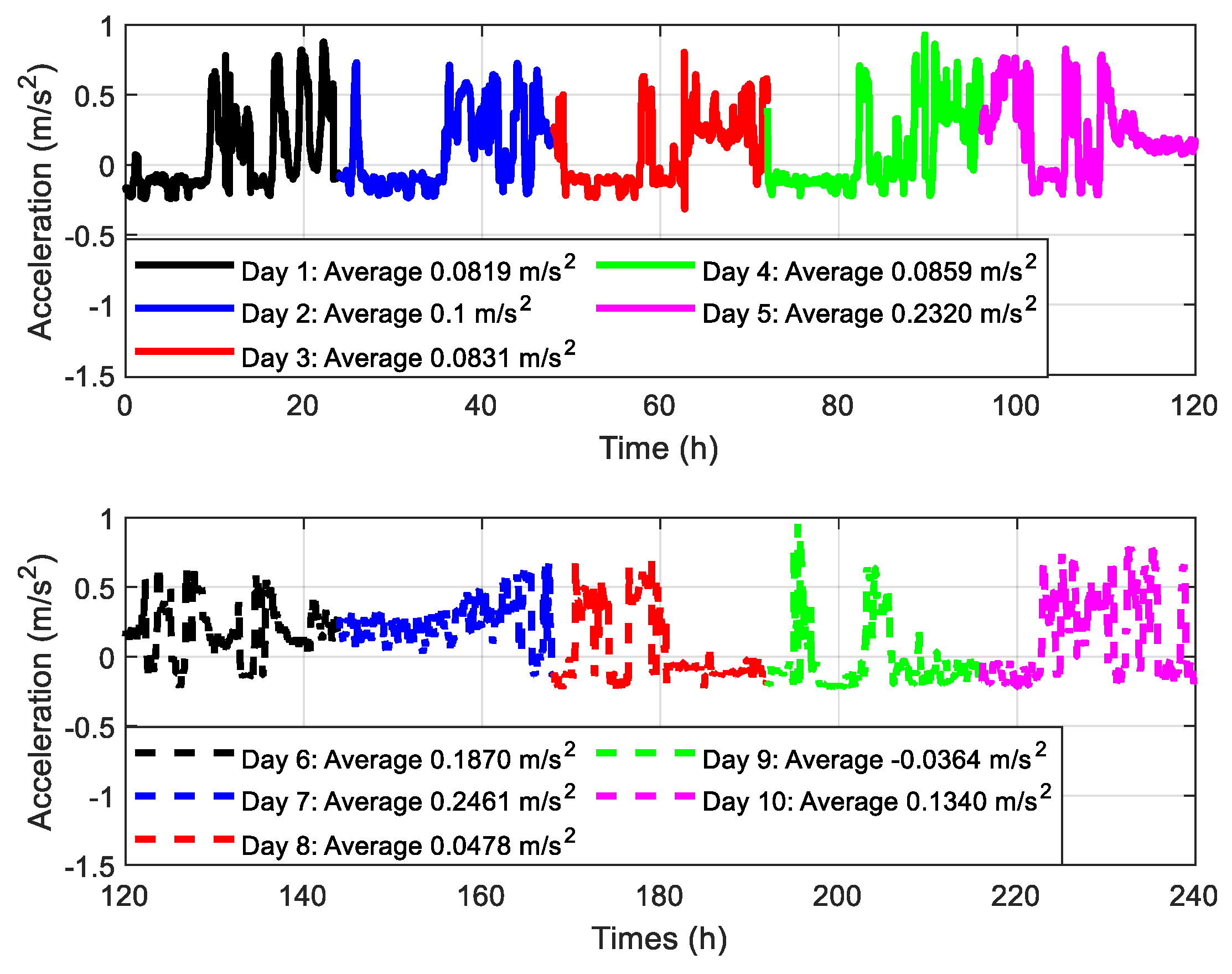
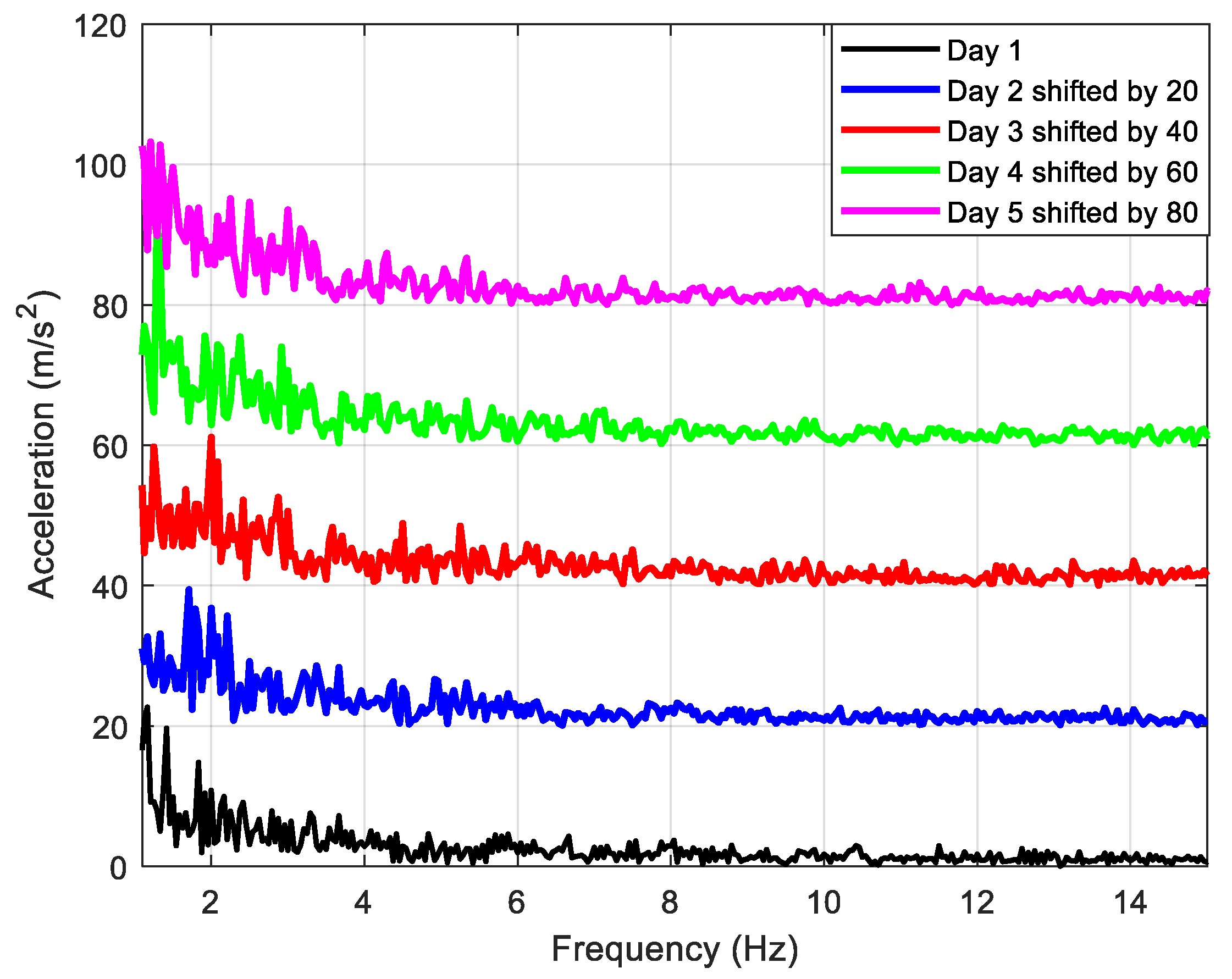

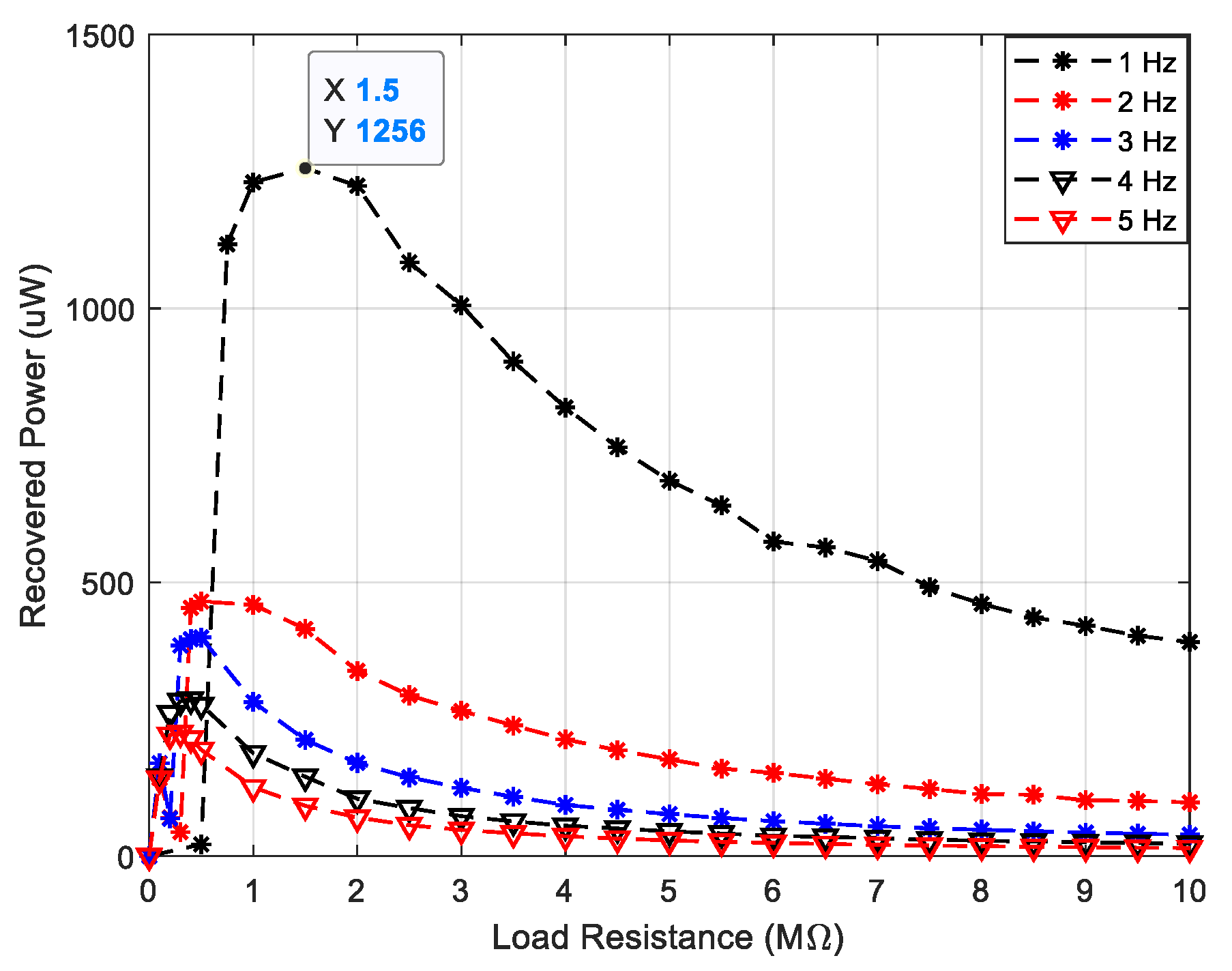
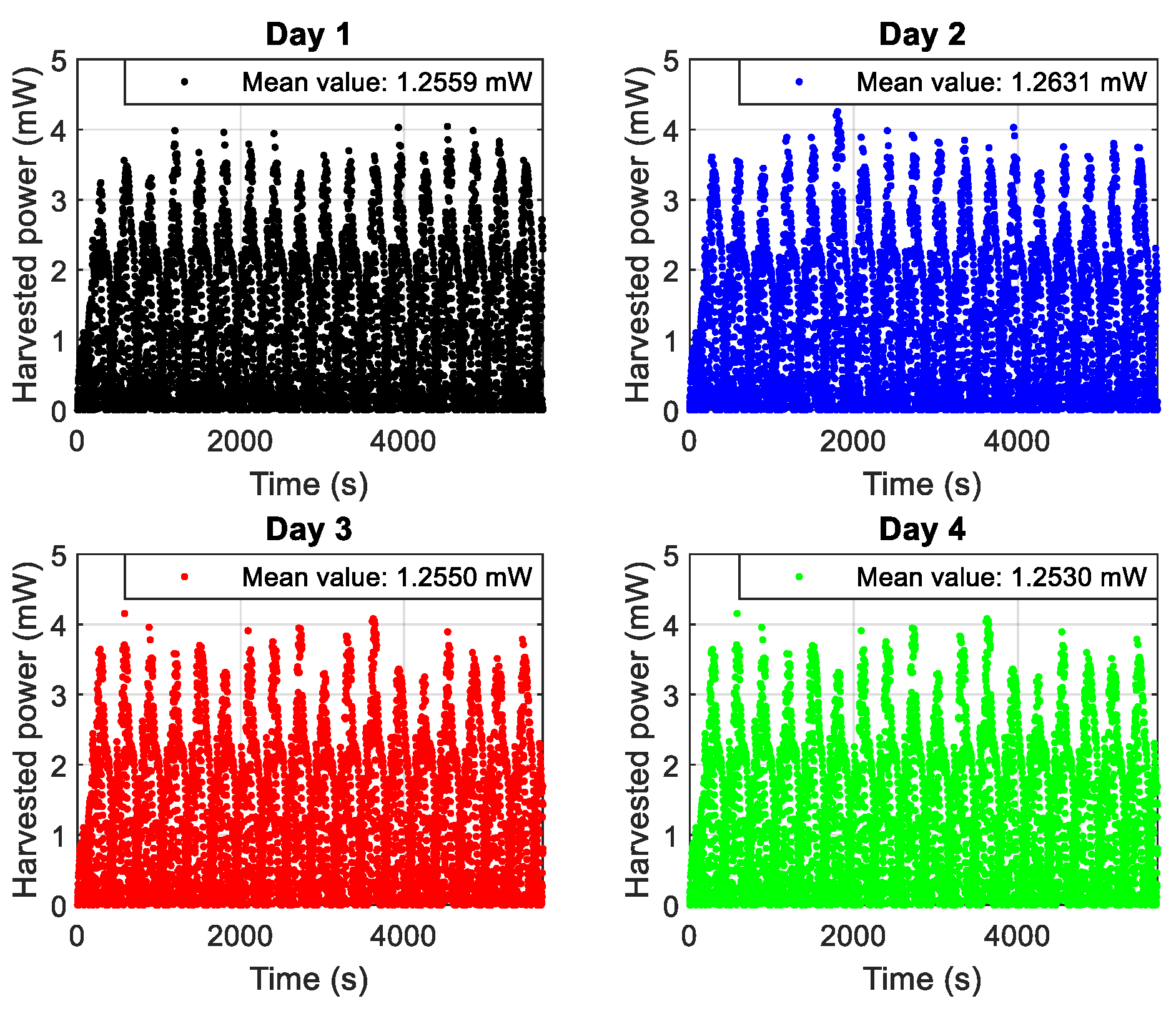




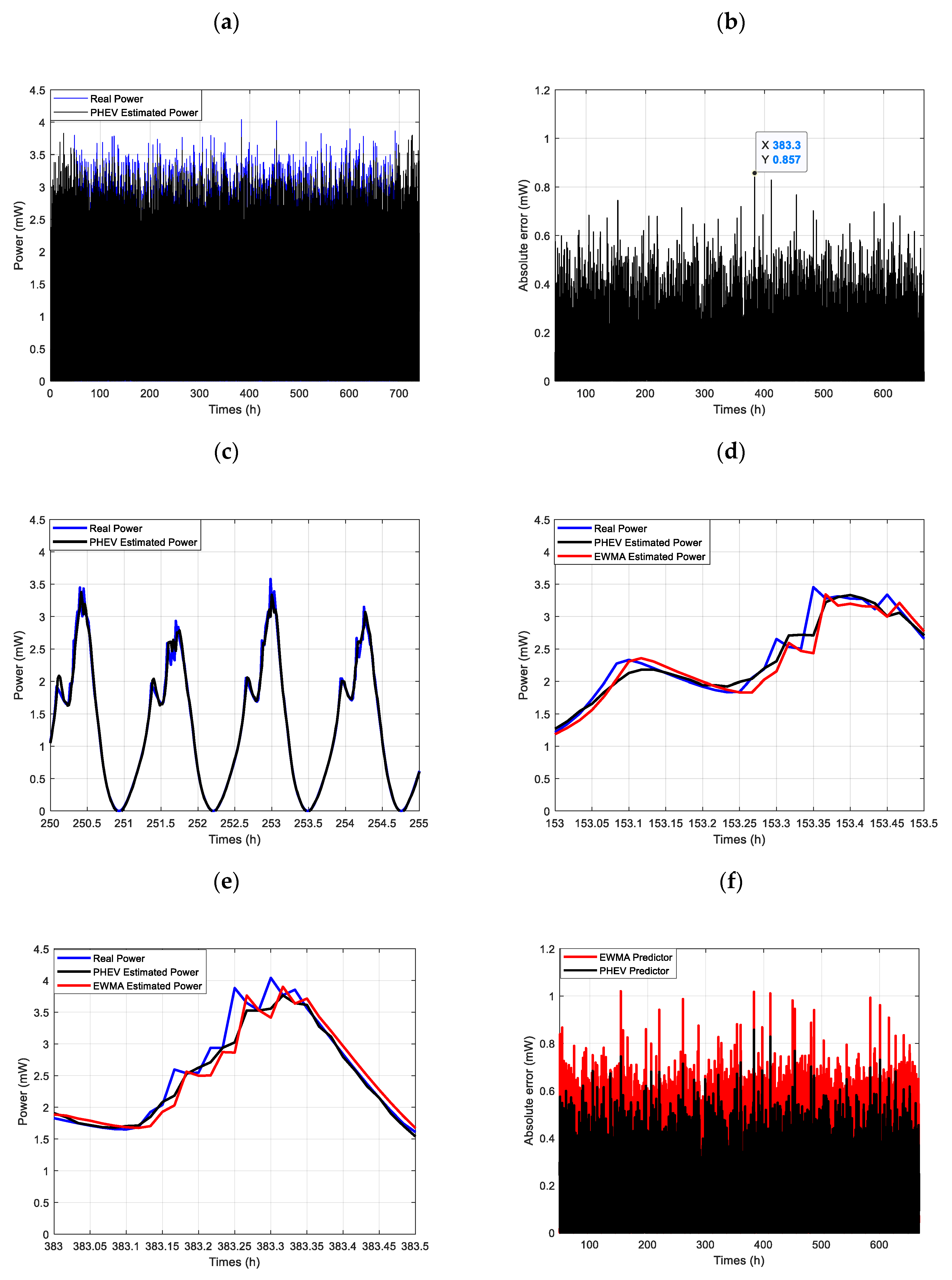
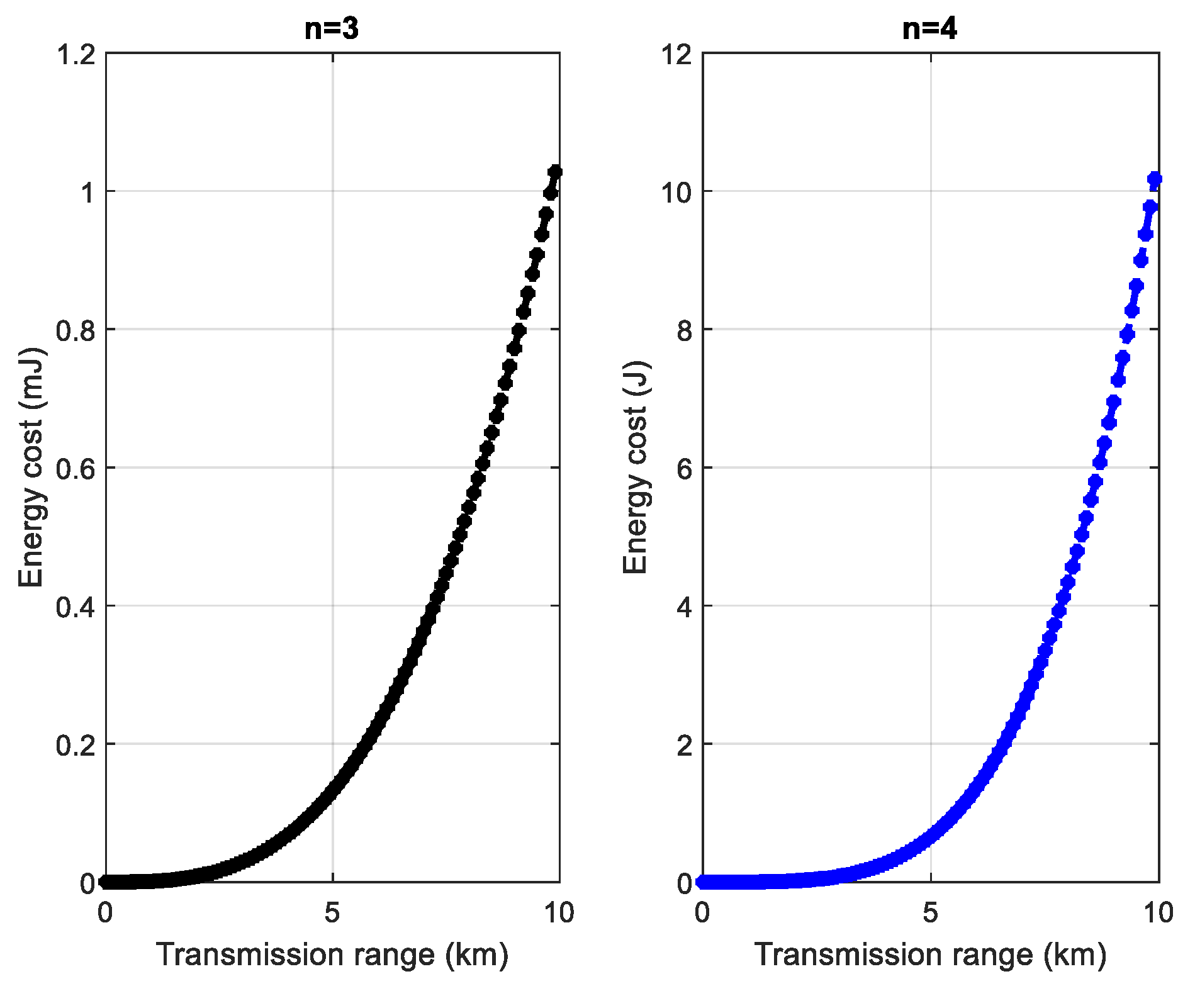
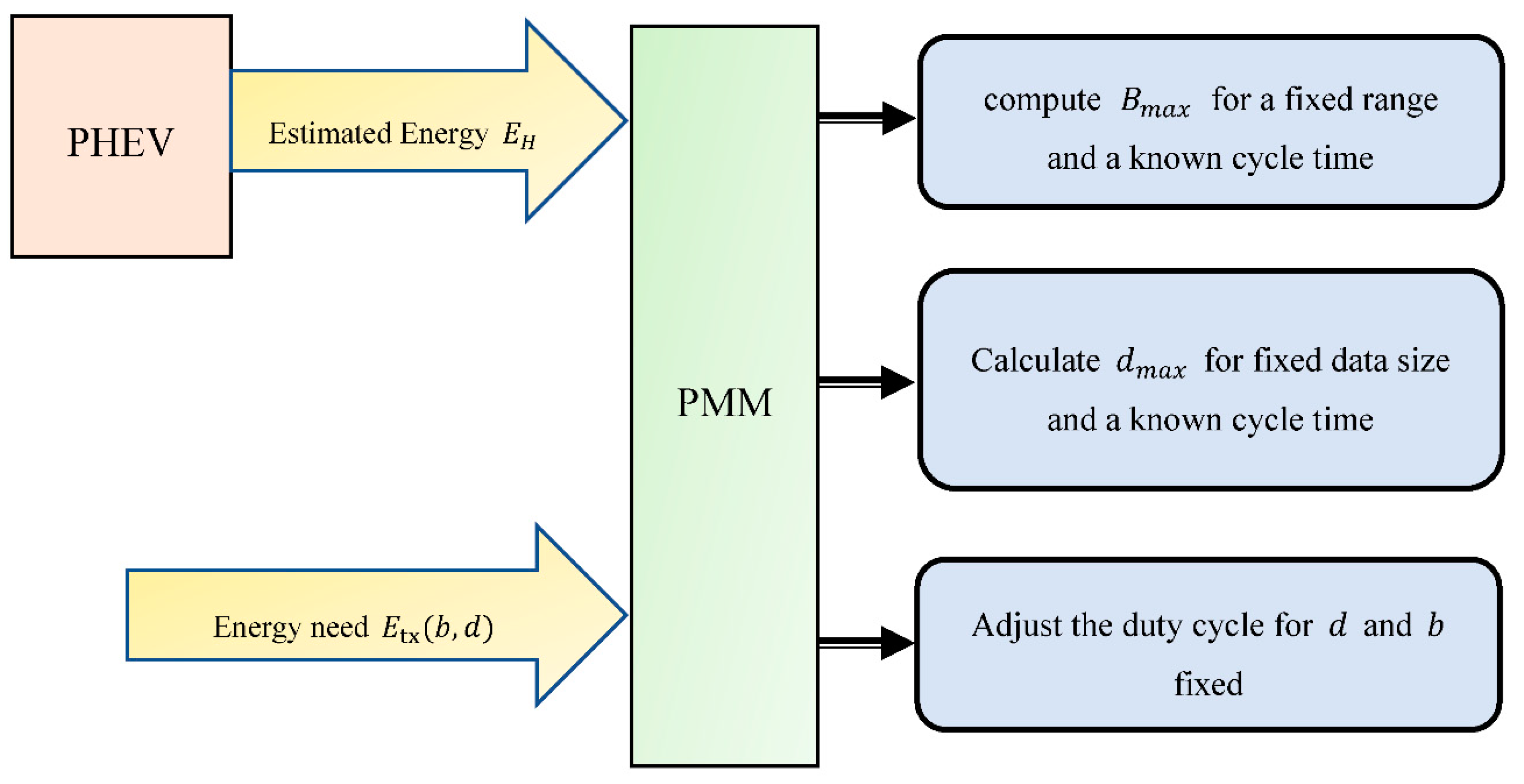


| Sensors | Microprocessor | Radio Chip | |||
|---|---|---|---|---|---|
| Components | Power consumption in active mode | Components | Power consumption in active mode | Components | Transmit power consumption |
| ADXL35 (Accelerometer of Analog Devices) | [29] | MSP430G2553 of Texas Instrument | [30] | CC2430 of Texas Instrument | [28] |
| STLM20 (Temperature sensor of ST) | [31] | MSP430L092 of Texas Instrument | [32] | CC2520 of Texas Instrument | [33] |
| MPL115A (Pressure sensor of Freescale) | [34] | ATMega128 of Atmel | [35] | SX1211 of Semtech | [36] |
| PT | Frequency Range (Hz) | Power | |
|---|---|---|---|
| Mide volture [37,39] | |||
| Piezo System [40] | |||
| MicroGen System [41] | and | ||
| PMG Perpetuum [42] | 50 and 60 Hz | --- |
| Parameter | Value |
|---|---|
| Stack area | |
| Blocking Force | |
| Test voltage | 40 |
| No-load displacement at test voltage volts | 0.016 |
| Electric capacitance | 145 |
| Resonant Frequency | 1 Hz |
| Predictor Metric | EWMA | PHEV | Improvement |
|---|---|---|---|
| Maximum absolute error | 1.02 | 0.857 | 16% |
| Relative error | 25.25 | 21.2 | 16.03% |
| RMSE | 28.63 | 19.52 | 31.82% |
| Parameter | Symbol | Value and Ref |
|---|---|---|
| Path loss exponent | 3 or 4 [61] | |
| LoRa transmitter/receiver frequency | [60] | |
| LoRa SX1280 transceiver sensitivity | −99 dBm [60] | |
| Spreading Factor | SF | [60] |
| Bandwidth | [60] |
| Ref (Year) | Applications (Acceleration @ Frequency) | Used Method | Throughput @Transmission Range@ Transmission Frequency |
|---|---|---|---|
| [64] (2005) | Data compression and HSU approach | − @ − @ | |
| [65] (2017) | HSU | − @ − @ | |
| [38] (2017) | HSU | − @ − @ | |
| [66] (2018) | Vehicles | HSU | |
| [19] (2020) | Mining locomotive | PT with SSHI and HSU | 1.21 bits/s @ 958 m @ 7 |
| This Work (2020) | SAG | PT with PHEV and MDSP |
Publisher’s Note: MDPI stays neutral with regard to jurisdictional claims in published maps and institutional affiliations. |
© 2020 by the authors. Licensee MDPI, Basel, Switzerland. This article is an open access article distributed under the terms and conditions of the Creative Commons Attribution (CC BY) license (http://creativecommons.org/licenses/by/4.0/).
Share and Cite
Mouapi, A.; Hakem, N.; Kandil, N. Piezoelectric Energy Harvesting Prediction and Efficient Management for Industrial Wireless Sensor. Appl. Sci. 2020, 10, 8486. https://doi.org/10.3390/app10238486
Mouapi A, Hakem N, Kandil N. Piezoelectric Energy Harvesting Prediction and Efficient Management for Industrial Wireless Sensor. Applied Sciences. 2020; 10(23):8486. https://doi.org/10.3390/app10238486
Chicago/Turabian StyleMouapi, Alex, Nadir Hakem, and Nahi Kandil. 2020. "Piezoelectric Energy Harvesting Prediction and Efficient Management for Industrial Wireless Sensor" Applied Sciences 10, no. 23: 8486. https://doi.org/10.3390/app10238486
APA StyleMouapi, A., Hakem, N., & Kandil, N. (2020). Piezoelectric Energy Harvesting Prediction and Efficient Management for Industrial Wireless Sensor. Applied Sciences, 10(23), 8486. https://doi.org/10.3390/app10238486





